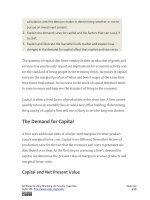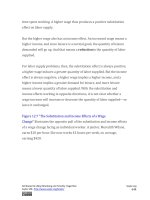Authors libby rittenberg 864
Bạn đang xem bản rút gọn của tài liệu. Xem và tải ngay bản đầy đủ của tài liệu tại đây (411.89 KB, 1 trang )
16.3 Regulation: Protecting People
from the Market
LEARNING OBJECTIVES
1. Compare the public interest and public choice theories of regulation.
2. Discuss the costs and benefits of consumer protection laws.
3. Discuss the pros and cons of the trend toward deregulation over the
last quarter century.
Antitrust policies are primarily concerned with limiting the accumulation
and use of market power. Government regulation is used to control the
choices of private firms or individuals. Regulation may constrain the
freedom of firms to enter or exit markets, to establish prices, to determine
product design and safety, and to make other business decisions. It may
also limit the choices made by individuals.
In general terms, there are two types of regulatory agencies. One group
attempts to protect consumers by limiting the possible abuse of market
power by firms. The other attempts to influence business decisions that
affect consumer and worker safety. Regulation is carried out by more than
50 federal agencies that interpret the applicable laws and apply them in
the specific situations they find in real-world markets. Table 16.2 "Selected
Federal Regulatory Agencies and Their Missions" lists some of the major
federal regulatory agencies, many of which are duplicated at the state
level.
Attributed to Libby Rittenberg and Timothy Tregarthen
Saylor URL: />
Saylor.org
864









